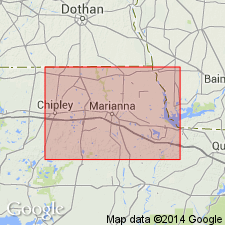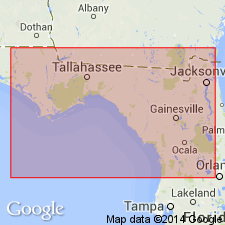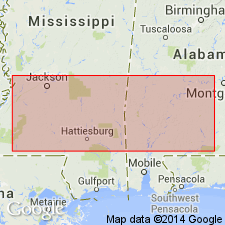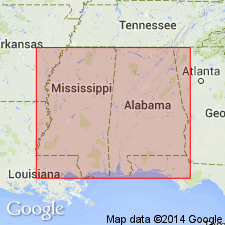
- Usage in publication:
-
- Bumpnose limestone member
- Modifications:
-
- Original reference
- Dominant lithology:
-
- Limestone
- AAPG geologic province:
-
- South Georgia sedimentary province
Summary:
Pg. 19 (fig. 4), 21 (table 1), 30, 36-42. Bumpnose limestone member of Crystal River formation. Beds younger than the Crystal River of Puri, occur in Jackson County at top of Ocala group. These beds are here named Bumpnose limestone and constitute uppermost member of formation. Contains LEPIDOCYCLINA (NEPHROLEPIDINA) CHAPERI Lemoine and R. Douville. Occurs above ASTEROCYCLINA zone of Crystal River and below Marianna limestone which contains LEPIDOCYCLINA (LEPIDOCYCLINA) MANTELLI (Morton). Soft easily crumbled white limestone generally more granular than typical Marianna. Thickness ranges from 0 to 15 feet; apparently thins to southeast where it is replaced in subsurface by Gadsden limestone southeast of Cypress fault. [Age is late Eocene.]
Type locality: quarry near center W/2 sec. 23, T. 5 N., R. 11 W., Jackson Co., northwestern FL. Named from exposures along and near Bumpnose Road, north and west of Marianna, Jackson Co., northwestern FL.
Source: US geologic names lexicon (USGS Bull. 1200, p. 532-533).

- Usage in publication:
-
- Bumpnose limestone member
- Modifications:
-
- Not used
- AAPG geologic province:
-
- South Georgia sedimentary province
Summary:
Pg. 33-34. Moore's Bumpnose member is not stratigraphically valid because beds for which name was proposed are not younger than the Crystal River of Puri since they underlie Marianna limestone of Oligocene age. The interval is a faunizone, and exactly the same beds are defined by MacNeil (1944, AAPG Bull., v. 28, p. 1313) as LEPIDOCYCLINA FRAGILIS faunizone at same outcrop.
Source: US geologic names lexicon (USGS Bull. 1200, p. 532-533).

- Usage in publication:
-
- Bumpnose Formation*
- Modifications:
-
- Overview
- AAPG geologic province:
-
- Mid-Gulf Coast basin
Summary:
Bumpnose Limestone Member of Crystal River Formation of Moore (1955) adopted and raised in rank to Bumpnose Formation as redefined by Cheetham (1963: GSA Memoir 91, 113 p.). Correlated with lower parts of Forest Hill and Red Bluff Formations. Age is early Oligocene. Eocene age in FL not ruled out.
Source: GNU records (USGS DDS-6; Reston GNULEX).

- Usage in publication:
-
- Bumpnose Limestone
- Modifications:
-
- Revised
- AAPG geologic province:
-
- Mid-Gulf Coast basin
Summary:
Bumpnose Limestone of Vicksburg Group is AL State usage. Unit is present in southeast AL, east of the Sepulga River. Thickness ranges from 13 to 17 ft. Grades westward into Red Bluff Clay. Age is early Oligocene.
Source: GNU records (USGS DDS-6; Reston GNULEX).

- Usage in publication:
-
- Bumpnose Limestone
- Modifications:
-
- Overview
- AAPG geologic province:
-
- Mid-Gulf Coast basin
Summary:
Current Geological Survey of Alabama usage includes the Forest Hill Sand, Red Bluff Clay, and Bumpnose Limestone in the Vicksburg Group and excludes the Chickasawhay Limestone. This usage is followed in the present report. Bumpnose, Red Bluff, and Forest Hill are facies equivalent strata that grade into one another laterally and vertically. In south-central AL, the Bumpnose includes about 14 ft of white, glauconitic, fossiliferous, argillaceous limestone. Rupelian Age based on planktonic Foraminifera. Eocene-Oligocene contact is placed at or near the base of the Bumpnose Limestone (Mancini and Waters, 1986: Journ. Foram. Research, v. 16, p. 24-33).
Source: GNU records (USGS DDS-6; Reston GNULEX).

- Usage in publication:
-
- Bumpnose Limestone
- Modifications:
-
- Overview
- AAPG geologic province:
-
- Florida platform
- Mid-Gulf Coast basin
Summary:
Related to the controversial placement of the Eocene-Oligocene boundary are the extent of the Bumpnose Limestone on the Florida Platform and the faunal affinities, age, and correlation of certain beds between the definitively Eocene Ocala Limestone and the Oligocene Suwannee Limestone. The typical Bumpnose is glauconitic and micritic limestone with abundant large foraminifers, bryozoans, and mollusks and is considered a calcareous facies of the Red Bluff Formation. Unit ranges from 3 to 4.5 m thick and it occurs in southern AL and portions of northern FL. Early Oligocene age has been confirmed by several workers based on calcareous nannoplankton, planktonic foraminifers, and macrofauna. Outside the type area in Jackson Co., the extent of the Bumpnose in FL is uncertain. Name has been loosely applied to strata in central FL where separation of lithostratigraphic units and biostratigraphic correlation are difficult. Use of the term Bumpnose Limestone in peninsular FL should probably be discontinued.
Source: GNU records (USGS DDS-6; Reston GNULEX).
For more information, please contact Nancy Stamm, Geologic Names Committee Secretary.
Asterisk (*) indicates published by U.S. Geological Survey authors.
"No current usage" (†) implies that a name has been abandoned or has fallen into disuse. Former usage and, if known, replacement name given in parentheses ( ).
Slash (/) indicates name conflicts with nomenclatural guidelines (CSN, 1933; ACSN, 1961, 1970; NACSN, 1983, 2005, 2021). May be explained within brackets ([ ]).

